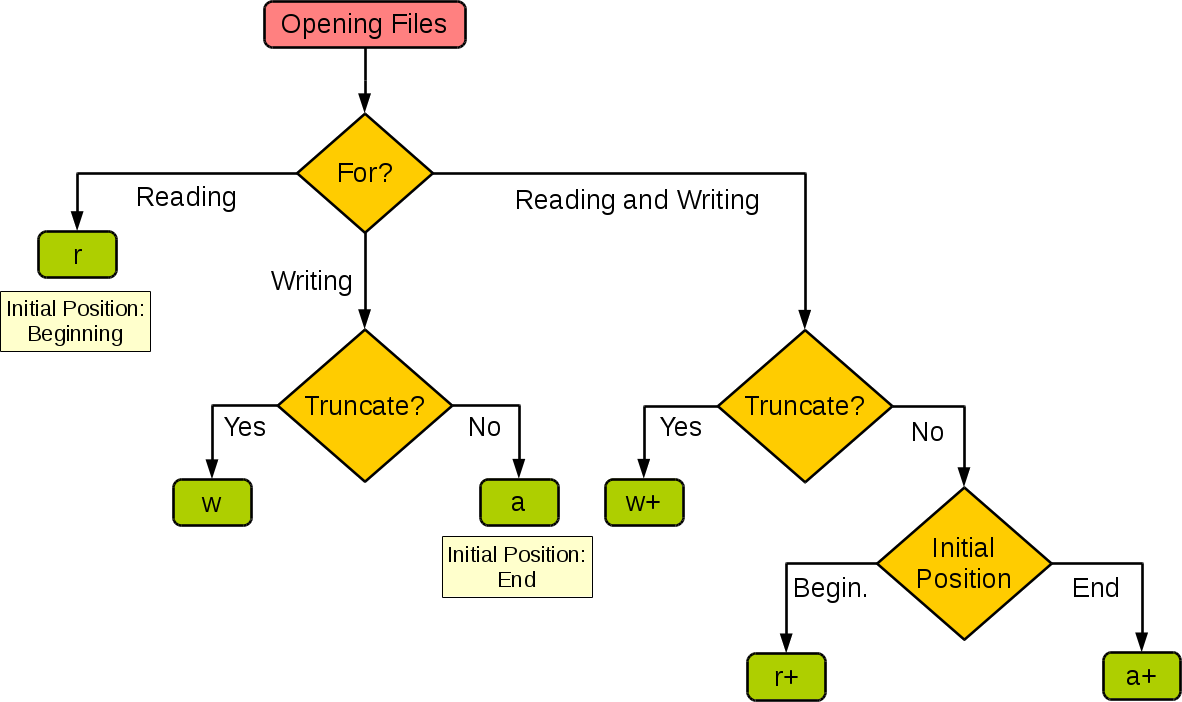Python常用库 ( 3 ) - 文件模块
一、文件路径相关(os.path)
路径相关的操作主要在os.path库。
1.1 判断文件、目录是否存在
1. os.path.exists: 判断文件/目录是否存在
>>> import os
>>> print os.path.exists.__doc__
Test whether a path exists. Returns False for broken symbolic links
# build目录
>>> os.path.exists("build")
True
# 1.txt文件
>>> os.path.exists("1.txt")
True
2. os.path.isdir: 判断是否是目录
>>> os.path.isdir("build")
True
>>> os.path.isdir("1.txt")
False
3. os.path.isfile: 判断是否是文件
>>> os.path.isfile("build")
False
>>> os.path.isfile("1.txt")
True
4. os.path.islink: 判断是否是软连
$ ln -s 1.txt v.txt
>>> os.path.islink("1.txt")
False
>>> os.path.islink("v.txt")
True
1.2 获取路径、目录、文件名
1. os.path.abspath: 获取所在文件的绝对路径
>>> os.path.abspath("1.txt")
'/Users/peng/workspace/python/demo/1.txt'
2. os.path.dirname: 获取目录
>>> os.path.dirname(os.path.abspath("1.txt"))
'/Users/peng/workspace/python/demo'
3. os.path.basename: 获取文件名
>>> os.path.basename(os.path.abspath("1.txt"))
'1.txt'
4. os.path.isabs: 是否是绝对路径
>>> os.path.isabs("1.txt")
False
>>> os.path.isabs("/Users/peng/workspace/python/demo/1.txt")
True
5. os.path.walk(): 遍历路径
1.3 路径处理
1. os.path.split: 切分路径
>>> os.path.split(os.path.abspath("1.txt"))
('/Users/peng/workspace/python/demo', '1.txt')
2. os.path.splitext:
>>> os.path.splitext(os.path.abspath("1.txt"))
('/Users/peng/workspace/python/demo/1', '.txt')
3. os.path.join: 合并路径
>>> os.path.join("/Users/peng/workspace/python/demo", "1.txt")
'/Users/peng/workspace/python/demo/1.txt'
二、操作文件目录(os)
本章节主要描述文件的创建、移动、拷贝、删除等操作。
2.1 添加/删除目录
1. 创建目录
- os.mkdir: 创建目录
- os.makedirs: 递归创建目录
>>> print os.mkdir.__doc__
mkdir(path [, mode=0777])
>>> os.mkdir("test")
# 递归创建时会抛异常
>>> os.mkdir("testa/testb")
Traceback (most recent call last):
File "<stdin>", line 1, in <module>
OSError: [Errno 2] No such file or directory:
递归创建目录
'testa/testb'
# 递归创建目录
>>> os.makedirs("testa/testb")
2. 删除目录
- os.rmdir: 删除单个目录
- os.removedirs: 递归删除目录
- os.remove: 删除文件
$ touch 1.md
>>> os.rmdir("test")
Traceback (most recent call last):
File "<stdin>", line 1, in <module>
OSError: [Errno 66] Directory not empty: 'test'
$ rm 1.md
>>> os.rmdir("test")
# 递归删除目录
>>> os.removedirs("testa/testb")
# 删除文件
>>> os.remove("1.md")
>>> os.remove("1.md")
Traceback (most recent call last):
File "<stdin>", line 1, in <module>
OSError: [Errno 2] No such file or directory: '1.md'
2.2 获取目录
1. os.listdir: 列出目录下的文件
>>> os.listdir("./test")
['1.md', 'folder']
2. os.getcwd: 获取当前工作目录
- os.getcwd: 获取当前工作目录
- os.chdir:切换工作目录
>>> print os.getcwd.__doc__
getcwd() -> path
>>> os.getcwd()
'/Users/peng/workspace/python/demo'
>>> os.chdir("./test")
>>> print os.getcwd()
/Users/peng/workspace/python/demo/test
2.3 重命名
1. os.rename: 获取当前工作目录
>>> print os.rename.__doc__
rename(old, new)
Rename a file or directory.
>>> os.rename("1.md", "2.md")
>>> os.rename("1.md", "2.md")
Traceback (most recent call last):
File "<stdin>", line 1, in <module>
OSError: [Errno 2] No such file or directory
三、读写文件操作
python内置文件相关操作,本章节主要描述对文件的读写操作。
3.1 操作流程
操作文件分为3个步骤:1. 打开文件 - 2. 读写文件 - 3. 关闭文件句柄
3.1.1 打开文件
调用open()函数打开文件并返回一个file对象
>>> print open.__doc__
open(name[, mode[, buffering]]) -> file object
Open a file using the file() type, returns a file object. This is the
preferred way to open a file. See file.__doc__ for further information
# Py3中第三个参数encoding可以指定文件编码。
f = open("1.txt", "r")
# 打印文件名
>>> print(f.name)
1.txt
# 打印文件对象是否已经关闭
>>> print(f.closed)
False
# 打印打开模式
>>> print(f.mode)
r
常用模式说明

| mode | 说明 |
|---|---|
| b | 二进制模式。 |
| + | 打开一个文件进行更新(可读可写)。 |
| r | 以只读方式打开文件。文件的指针将会放在文件的开头。这是默认模式。 |
| r+ | 打开一个文件用于读写。文件指针将会放在文件的开头。 |
| w | 打开一个文件只用于写入。如果该文件已存在则打开文件,并从开头开始编辑,即原有内容会被删除。如果该文件不存在,创建新文件。 |
| w+ | 打开一个文件用于读写。如果该文件已存在则打开文件,并从开头开始编辑,即原有内容会被删除。如果该文件不存在,创建新文件。 |
| a | 打开一个文件用于追加。如果该文件已存在,文件指针将会放在文件的结尾。也就是说,新的内容将会被写入到已有内容之后。如果该文件不存在,创建新文件进行写入。 |
| a+ | 打开一个文件用于读写。如果该文件已存在,文件指针将会放在文件的结尾。文件打开时会是追加模式。如果该文件不存在,创建新文件用于读写。 |
3.1.2 读写文件
调用read()或write()等方法读写文件
>>> print file.read.__doc__
read([size]) -> read at most size bytes, returned as a string.
If the size argument is negative or omitted, read until EOF is reached.
Notice that when in non-blocking mode, less data than what was requested
may be returned, even if no size parameter was given.
f.read()
read函数接收一个读取的字节数,如果不指定默认读取到结束符为止。
3.1.3 关闭句柄
f.close()
操作使用完后需要手动调用close()方法,Python里引入with语句可以在with代码块作用域结束后自动关闭文件,如:
with open("1.txt", "r") as f:
t = f.read()
print(t)
print(f.closed)
# Output:
The Zen of Python, by Tim Peters
Beautiful is better than ugly.
Explicit is better than implicit.
Simple is better than complex.
...
Namespaces are one honking great idea -- let's do more of those!
True
3.2 文件读取
常用的读取函数有:
read()默认读取整个文本内容readline()读取一行内容readlines()读取整个文件行返回到list中,相当于调用readline()直到EOF,并将结果放在list中。
调用readline读取
通过readlines可以看到每一行即便看起来是空白行,其实也是有空白字符\n,所以可以用if not t来判断是否读取到文件尾。
f = open("1.txt", "r")
while True:
t = f.readline()
print(t)
if not t:
break
f.close()
# Output:
The Zen of Python, by Tim Peters
...
调用readlines读取
可方便对读取到的每行内容做数据处理,省去读取整个文本后在切割的过程。可以看到输出的行尾都有换行符。可以批量去除:[l.strip() for l in t]
import json
f = open("1.txt", "r")
t = f.readlines()
print(json.dumps(t))
f.close()
# output:
[
"The Zen of Python, by Tim Peters\n",
"\n",
"Beautiful is better than ugly.\n",
"Explicit is better than implicit.\n",
"Simple is better than complex.\n"
]
3.3 文件写入
写入主要有write()和writelines()方法。熟悉前面文件的操作流程和打开方式后,写入就比较好理解了。常用的写入模式(w、a+)
通过write写入
f = open("x.txt", "a+")
while True:
s = input("Pls input something:")
f.write(s)
f.flush()
f.close()
通过writelines写入
f3 = open("3.txt", "w")
f3.writelines(t)
f3.close()
3.4 其他方法
3.4.1 truncate()
>>> print file.truncate.__doc__
truncate([size]) -> None. Truncate the file to at most size bytes.
Size defaults to the current file position, as returned by tell().
用于清空文本内容或者只保留前N个字符。
f = open("1.txt", "r+")
# 只保留前10个字符,不传则清空了文本内容
f.truncate(10)
f.close()
3.4.2 tell() 和 seek()
tell() -> current file position, an integer (may be a long integer).用于返回文件指针所在的位置。
seek(offset[, whence]) -> None. Move to new file position.用于移动文件指针。
比如在行一行处理大文件时,可能前面N行已经处理成功,记录一下此时的文件位置,下次启动时可以直接移动文件指针接着继续处理。
读取2行后打印文件位置,并继续读取一行:
f = open("1.txt", "r+")
f.readline()
f.readline()
print(f.tell())
print(f.readline())
f.close()
# Output:
34
Beautiful is better than ugly.
直接移动文件指针到34的位置读取一行。可以看到输出内容是一致。
f = open("1.txt", "r+")
f.seek(34)
print(f.readline())
f.close()
# Output:
Beautiful is better than ugly.
3.4.3 flush()
flush() -> None. Flush the internal I/O buffer.
2016-03-15 23:35
Python
